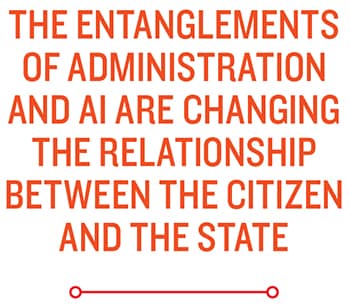
The Indian Algorithmic Services: When AI gets to decide who gets welfare
Certain kinds of technologies, colloquially and collectively labelled as artificial intelligence, are gradually replacing bureaucratic agency in making important executive decisions and government functions that have social consequences
 Image: Shutterstock
Image: Shutterstock
 Chapter 4 of the 2018-19 Economic Survey lays out an ambitious roadmap for the government of India to use data ‘of the people, by the people, and for the people’. Part of the report is dedicated to praising the Samagra Vedika initiative of the government of Telangana, described as a scheme which integrates data across government databases.
Chapter 4 of the 2018-19 Economic Survey lays out an ambitious roadmap for the government of India to use data ‘of the people, by the people, and for the people’. Part of the report is dedicated to praising the Samagra Vedika initiative of the government of Telangana, described as a scheme which integrates data across government databases.
The Telangana government claims that the Samagra Vedika system utilises a number of technologies which can be described as ‘artificial intelligence’ or AI—it uses ‘big data’ and complex machine learning systems to make predictions about people’s behaviour, and uses these predictive analytics to ultimately process applications for welfare schemes. More specifically, Samagra Vedika has been used to identify the eligibility of welfare beneficiaries and remove potentially fraudulent or duplicate beneficiaries.
By its own description, in 2016, the use of the Samagra Vedika system for removing so-called fraudulent ration cards led to the cancellation of 100,000 cards. Subsequently, government documents describe ‘public resistance’ to the cancellation, which led to the re-addition of 14,000 cards. While governments across all levels heap praise on the cost-cutting and efficiency of AI-based applications like Samagra Vedika in resource-constrained contexts like welfare administration in India, they are silent on the wider implications of using these systems to make fundamental policy and administrative decisions.
Samagra Vedika is only one of the various kinds of ‘AI’ technologies that are being used in government administration today. From policy decisions about managing urban travel and allocating police patrols to making decisions about individual entitlements for welfare schemes or deliberating income tax disputes, administrative agencies in India are routinely turning to automation and AI to aid, automate or even entirely replace human agency involved in these decisions.
It is important to study the implications of contemporary AI systems owing to their use of multiple sources of data, complex statistical and computational logics to analyse and process this data, and their increasing use in decisions with social consequences. The entanglements of government administration and AI are fundamentally changing the nature of governance and the relationship between the citizen and the state.



 However, the use of AI in decision-making processes again fundamentally alters how natural justice and procedural safeguards should be applied. Decisions made with the use of AI are not always interpretable or explainable in a way that can allow affected individuals to understand and contest them. Further, in the absence of any specific law and policy on automated decisions in India, there is no structural manner in which these obligations can be enforced. Failures of such protections have been observed in a number of cases where government agencies are using AI or algorithmic systems, from the denial of benefits using
However, the use of AI in decision-making processes again fundamentally alters how natural justice and procedural safeguards should be applied. Decisions made with the use of AI are not always interpretable or explainable in a way that can allow affected individuals to understand and contest them. Further, in the absence of any specific law and policy on automated decisions in India, there is no structural manner in which these obligations can be enforced. Failures of such protections have been observed in a number of cases where government agencies are using AI or algorithmic systems, from the denial of benefits using 



